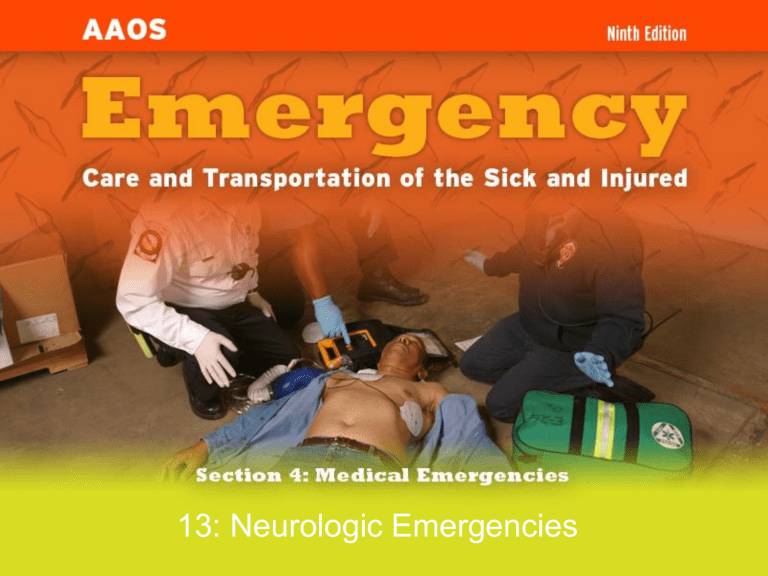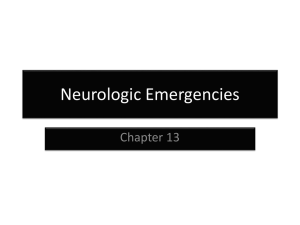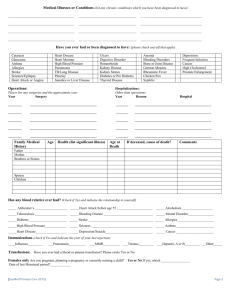SECTION 2

13: Neurologic Emergencies
Brain Structure and Function
The Spinal Cord
Common Causes of Brain
Disorder
(1 of 2)
• Many different disorders can cause brain dysfunction and can affect LOC, speech, and muscle control.
• If problem is caused by heart and lungs, entire brain will be affected.
• If problem is in the brain, only that portion of brain will be affected.
Common Causes of Brain
Disorder
(2 of 2)
• Stroke is a common cause of brain disorder and is treatable.
• Seizures and altered mental status are other causes of brain disorder.
Cerebrovascular Accident and Stroke
• Cerebrovascular accident
– Interruption of blood flow to the brain that results in the loss of brain function
• Stroke
– The loss of brain function that results from a
CVA
Potential Results of a CVA
• Thrombosis—Clotting of cerebral arteries
• Arterial rupture—Rupture of a cerebral artery
• Cerebral embolism—
Obstruction of a cerebral artery caused by a clot that was formed elsewhere and traveled to the brain
Hemorrhagic Stroke
• Results from bleeding in the brain
• High blood pressure is a risk factor.
• Some people are born with aneurysms.
Ischemic Stroke
• Results when blood flow to a particular part of the brain is cut off by a blockage inside a blood vessel
Atherosclerosis
Transient Ischemic Attack (TIA)
• A TIA is a “mini-stroke.”
• Stroke symptoms go away within 24 hours.
• Every TIA is an emergency.
• TIA may be a warning sign of a larger stroke.
• Patients with possible TIA should be evaluated by a physician.
Signs and Symptoms of Stroke
(1 of 2)
• Left hemisphere
– Aphasia: Inability to speak or understand speech
– Receptive aphasia: Ability to speak, but unable to understand speech
– Expressive aphasia: Inability to speak correctly, but able to understand speech
Signs and Symptoms of Stroke
(2 of 2)
• Right hemisphere
– Dysarthria: Able to understand, but hard to be understood
Stroke Mimics
• Hypoglycemia
• Postictal state
• Subdural or epidural bleeding
You are the Provider
• You and your paramedic partner arrive to a 70year-old man with a severe headache and decreased level of consciousness.
• He is seated in the kitchen with his wife standing next to him.
You are the Provider continued • When you speak to him, he stares at you blankly.
• You notice that he is drooling from the right side of his mouth.
• His wife says, “A few minutes ago, he told me that he had a very bad headache.”
• “When I came back from the bathroom with some ibuprofen, I tried to hand him a glass of water and he dropped the glass on the floor.
I don’t know what’s wrong with him.”
You are the Provider continued
• What do you suspect is wrong with this patient?
• What other signs and symptoms would you suspect in this scenario?
• What tests could you use to verify your suspicions?
Scene Size-up
• Scene safety remains a priority.
• Ensure that needed resources are requested.
• Consider spinal immobilization.
• Be aware that many serious medical conditions can mimic stroke; consider all possibilities.
Initial Assessment
• Chief complaint may include confusion, slurred speech, or unresponsiveness.
• Patient may have difficulty swallowing or choke on own saliva.
• Ensure adequate airway.
• If unresponsive, place in recovery position.
• Administer oxygen.
• Raising patient’s arms and legs may aggravate hemorrhage.
You are the provider continued (1 of 2)
• You utilize a portion of the Cincinnati Stroke Scale by asking the patient to smile.
• He attempts, but the right side of his face remains flaccid.
• You assist the patient to the cot and place him upright, slightly on his affected side.
• As you obtain a quick set of baseline vital signs, your partner applies high-flow oxygen.
You are the provider continued (2 of 2)
• What other types of disorders or conditions can mimic a stroke?
• Can all strokes be treated with clot-busting medications?
Transport Decision
• Thrombolytics may reverse stroke symptoms or stop a stroke if given within 2 to 3 hours of onset.
• Spend as little time on scene as possible.
• Place paralyzed side down and well protected with padding.
• Elevate head approximately 6".
Focused History and Physical Exam
• Quickly determine when patient last appeared normal.
• Medications may give you a clue to the patient’s past medical history.
• Patient may still be able to hear and understand; be careful what you say.
Cincinnati Stroke Scale
• Speech
– Abnormal if words are slurred or confused
• Facial droop
– Abnormal if asymmetrical
• Arm drift
– Abnormal if arms do not move equally
Baseline Vital Signs
• Excessive bleeding in the brain may slow pulse and cause erratic respirations.
• Blood pressure is usually high.
• Excessive bleeding in the brain may cause changes in pupil size and reactivity.
Interventions
• Based on assessment findings
• If the patient is unresponsive, you may consider the recovery position to protect the airway.
Detailed Physical
Exam
• Perform when time and conditions permit.
• Generally performed en route to the hospital.
• Do not delay transport, especially due to the time sensitivity of stroke treatment.
Ongoing Assessment
• Reassess ABCs, interventions, vital signs.
• Stroke patients can lose airway without warning.
• Watch for changes in GCS scores.
• Relay information to the hospital as soon as possible.
• Report any pertinent physical findings, Cincinnati
Stroke Scale, GCS score, any other changes.
You are the provider continued (1 of 2)
• Your partner tells you that he will initiate an IV en route.
You assist the patient’s wife into the ambulance and immediately begin transport using lights and siren.
• You do your best to address their concerns about the noise and driving safely. You hear the paramedic performing the rest of the stroke scale.
• What would this include?
You are the provider continued (2 of 2)
• Your partner asks the patient to hold his hands out in front of him palms up and eyes closed.
• He then asks the patient to repeat a simple declarative statement.
• The findings indicate the presence of stroke.
• He assigns this patient a GCS score and obtains another set of vital signs.
• What would the paramedic have seen if the remaining tests indicated a stroke?
Emergency Care for Stroke
• Patient needs to be evaluated by computed tomography (CT).
• Recognizing the signs and symptoms of stroke can shorten the delay to CT.
• Treatment needs to start as soon as possible, within 3 to 6 hours of onset.
Seizures
• Generalized (grand mal) seizure
– Unconsciousness and generalized severe twitching of the body’s muscles that lasts several minutes
• Absence (petit mal) seizure
– Seizure characterized by a brief lapse of attention
Signs and Symptoms of Seizures
• Seizures may occur on one side or gradually progress to a generalized seizure.
• Usually last 3 to 5 minutes and are followed by postictal state
• Patient may experience an aura.
• Seizures recurring every few minutes are known as status epilepticus.
Causes of Seizures
• Congenital (epilepsy)
• High fevers
• Structural problems in the brain
• Metabolic disorders
• Chemical disorders (poison, drugs)
• Sudden high fever
Recognizing Seizures
• Cyanosis
• Abnormal breathing
• Possible head injury
• Loss of bowel and bladder control
• Severe muscle twitching
• Postseizure state of unresponsiveness with deep and labored respirations
Postictal State
• Patient may have labored breathing.
• May have hemiparesis: weakness on one side of the body.
• Patient may be lethargic, confused, or combative.
• Consider underlying conditions:
– Hypoglycemia
– Infection
Scene Size-up
• Spinal immobilization may be needed with a seizure.
• Ensure that scene is safe and wear BSI.
• Request ALS assistance earlier rather than later.
Initial
Assessment
• Most seizures last only a few minutes at most.
• Assess level of consciousness.
• Use AVPU scale to determine how well patient is progressing through postictal stage.
• Focus on ABCs upon arrival.
• Expect pulse to be rapid and deep.
• Pulse should slow to normal rates after several minutes.
Transport Decision
• It is difficult to package a seizing patient for transport.
• Treat ABCs while waiting for seizure to finish.
• Protect the seizing patient from his or her surroundings.
• Never restrain an actively seizing patient.
• Not every patient who has a seizure wishes to be transported.
• Encourage every patient to be seen and evaluated in the emergency department.
Focused History and Physical
Exam
• Obtain some information from family or bystanders.
• Observe patient for recurrent seizures.
• If the patient displays an altered mental status, perform a rapid physical exam.
• If patient is responsive, begin with SAMPLE history.
• If the patient has an altered mental status, utilize the Glasgow Coma Scale.
Interventions
• Most seizures will be over by the time you arrive.
• Treat trauma as you would for any other patient.
• For patients who continue to seize, suction the airway according to local protocol, provide positive pressure ventilation, transport quickly to hospital.
• Consider rendezvous with ALS, who have medications to stop prolonged seizures.
Detailed Physical Exam
• If life threats are treated, consider performing detailed physical exam.
• Check patient for injuries, including tongue.
• Assess for weakness or loss of sensation on one side of body.
Ongoing Assessment
• Note additional seizure activity.
• Reassess ABCs, interventions, vital signs.
• Provide complete history to receiving facility.
• Include descriptions of seizure from witnesses if available.
• Document whether this is first seizure or whether patient has history of seizures.
Emergency Medical Care for Seizure
• Most patients should be evaluated by a physician after a seizure.
• With severe injury, suspect spinal injury.
• Attempt to lower body temperature if febrile seizure.
• Patient and family may be frightened.
Altered Mental Status
• Hypoglycemia
• Hypoxemia
• Intoxication
• Drug overdose
• Unrecognized head injury
• Brain infection
• Body temperature abnormalities
• Brain tumors
• Glandular abnormalities
• Poisoning
Assessing a Patient With AMS
• Same assessment process
• Patient cannot tell you reliably what is wrong.
• Be vigilant in ongoing assessment.
• Monitor for changes or deterioration.
• Provide prompt transport to hospital while monitoring the patient.







